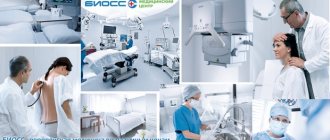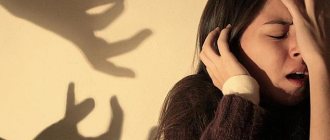Article:
Astheno-neurotic syndrome in children is a common pathology of the nervous system, which occurs as a result of overwork and severe emotional shock.
With neurasthenia, children look healthy, but tired. Symptoms of astheno-neurotic syndrome in children are similar to the clinical manifestations of depression, vegetative-vascular dystonia, and chronic fatigue.
People who are far from medicine do not know what astheno-neurotic syndrome in children is and how to treat this disease. It is often difficult for parents to suspect a nervous system disorder in their child, since they attribute moodiness, fatigue, and tearfulness to the child’s character traits. As a result, instead of helping a child suffering from a neurotic disorder, parents scold and punish him, aggravating the situation.
GENERAL INFORMATION ABOUT PATHOLOGY
Neurasthenia in children is a symptom complex that occurs as a result of exhaustion of the nervous system. The symptoms of neurasthenia in children differ from the signs of neurasthenia in adults.
Doctors call this disease irritable fatigue syndrome. Asthenoneurosis occurs not only in children, but also in adolescents. This disorder is one of the common causes of a decrease in a child’s school performance and conflict in relationships with peers and adults.
Asthenoneurosis can be a consequence of intrauterine pathology of the development of the nervous system, birth trauma, or an infection suffered by the baby in the early postnatal period. In this case, signs of the disease appear at 2–3 years. The disease can also develop at school age as a result of excessive stress on the nervous system.
Symptoms and signs of neurasthenia in children should be a reason to visit a doctor. Without timely treatment, they will lead to irreversible changes in the child’s psyche.
List of used literature
- Grishchenko E.V. Methods for correcting asthenic syndrome in outpatient practice // “medical council”, 2012 - p. 36-37
- Kolyutskaya E. V. Modern approaches to psychopharmacotherapy of anxiety disorders // Pharmaceutical Bulletin: information and analytical newspaper. 2005. - p. 112-116
- Vein L. M., Voznesenskaya T. G., Vorobyova O. V. et al. Autonomic disorders: clinical picture, treatment, diagnosis / ed. A. M. Veina. M.: medical information agency. - 1998. - 752 p.
SYMPTOMS OF THE DISEASE
Symptoms of the disease are associated with disturbances in the functioning of the nervous system. Clinical psychologists and psychiatrists classify the signs of the disease into 2 groups:
- Symptoms caused by disturbances in the functioning of the autonomic nervous system. Symptoms of this group include all physiological manifestations of neurasthenia: increased sweating, physiological dependence on sweets, enuresis, heart rate deviation from the average age norm, decreased blood pressure, decreased immunity to colds.
- Symptoms caused by disturbances in brain function. This group of symptoms includes behavioral manifestations of neurasthenia: causeless mood swings, inadequate reactions to the words and actions of others, poor control of emotional manifestations, sleep disturbances, a predominance of low mood, depression, decreased voluntary memory and concentration, motor disinhibition, and the appearance of various phobias.
SYMPTOMS IN CHILDREN 2–6 YEARS OLD
Astheno-neurotic syndrome in preschool children manifests itself in the form of:
- fearfulness, phobias, excessive impressionability;
- logoneurosis in the form of rapid speech and unclear sound pronunciation
- tearfulness, moodiness;
- irritability and short temper;
- unmotivated aggression towards peers, self-aggression;
- abuse of toys;
- tendency to tear, break, spoil things, books;
- restlessness and fussiness, motor disinhibition, obsessive movements;
- depressed mood;
- convulsive syndrome and nervous tics;
- restless sleep;
- loss of interest in favorite games, lethargy;
- psychosomatic manifestations (pain in the neck and arms, constipation).
SYMPTOMS IN SCHOOLCHILDREN
Symptoms of astheno-neurotic syndrome in school-age children are:
- irritability and nervous excitability;
- vulnerability, touchiness;
- isolation;
- fatigue, decreased performance;
- increased situational and personal anxiety and causeless worry;
- mood swings;
- panic attacks and phobias;
- decreased concentration of voluntary attention;
- a sharp decline in academic performance;
- headache;
- sleep problems;
- appetite disorder;
- Vivid emotional outbursts in the form of screaming, falling to the floor, hysterics.
general characteristics
A brief description of the astheno-neurotic psychotype is determined by the following character traits and characteristics:
- increased fatigue;
- irritability, short temper, lack of restraint;
- often - bad mood;
- in the morning - drowsiness and “weakness”;
- hypochondria;
- sudden affective outbursts at the slightest, meaningless reason;
- emotional breakdowns when plans fail;
- accuracy;
- discipline, diligence, flexibility;
- low self-esteem;
- due to excessive fatigue - forgetfulness, lethargy, low activity;
- physical labor is more preferable than mental labor.
The astheno-neurotic type is included in the classification of character accentuations according to Lichko. Leonhard calls it anxious-fearful.
Recommended hobbies for an astheno-neurotic person are any collecting, as well as non-exhausting sports (like stretching or Finnish walking).
The most striking examples of famous fictional astheno-neurotics are Eeyore from Winnie the Pooh and Melman the giraffe from Madagascar.
An example from life. A young woman came to see a family psychologist. She recently married her colleague. They worked together for 2 years. At the same time, he was a very disciplined and efficient worker: he always submitted all reports on time, was never rude to anyone, and never gossiped with anyone. When they started dating, it seemed to her that he focused too much attention on himself, namely on his even the most minor ailments and problems. But overall, they had a good relationship and got married. After that, everything went wrong: after work, the husband literally fell on the sofa and got up only a couple of hours before bedtime to have a snack and take a shower. He was exhausted from any effort - both moral and physical. And, of course, the lion's share of the family budget began to go to his ghostly, most often fictitious, illnesses. She was tired of this and came to ask for advice from a psychologist, who explained to her that her husband was a typical representative of the astheno-neurotic psychotype.
STAGES OF ASTHEN-NEUROTIC SYNDROME
The following stages are distinguished in the development of a neurotic disorder:
- Hypertensive neurasthenia. At this stage, the patient experiences increased excitability and irritability, emotional sensitivity, decreased efficiency in performing mental or physical labor, absent-mindedness, girdling headache, and sleep problems.
- Irritable weakness. The disease moves to the second stage if the patient ignored the initial signs of the disease and did not seek medical help. This stage is characterized by the fact that a person can no longer hide his irritability, his nervous system is quickly depleted. The patient cannot concentrate on the production or educational tasks facing him due to constant headaches and weakness in the body. A person feels overwhelmed in the morning.
- Hyposthenic neurasthenia. If you do not see a doctor at the second stage, the disease develops into stage 3. The patient develops chronic fatigue, sad mood, apathy, and drowsiness. Psychosomatic disorders appear: skin itching, hair loss, brittle nails, pain in the spine and joints, decreased hearing and visual acuity, exacerbation of chronic diseases.
Dysthymia – depressive neurotic disorder
The disease is characterized by a depressed state in the patient, which does not go away for more than 2 years. The pathology is characterized by decreased vital energy and increased fatigue. A person feels apathy and is unable to enjoy life. Self-esteem decreases and self-confidence is lost. Such people rarely share their emotions with others. The most severe consequence is suicide. The patient is referred to a psychotherapist. With timely treatment, dysthymia, or depressive neurotic disorder, is treatable.
VARIETIES OF SYNDROME
Experts have come to the conclusion that astheno-neurotic syndrome in children is a disease that can be found in such forms as:
- Cerebrasthenic asthenoneurosis is a congenital pathology caused by organic lesions of the brain.
- Residual asthenia is a congenital type of neurosis that occurs as a result of pathology of the nervous system or as a result of a birth injury to the head. Manifestations of this type of disease are tearfulness, enuresis, and impaired fine and gross motor skills.
- Somatogenic asthenia is a type of psychosomatic illness. As a rule, this type of neurosis develops in children with a history of disturbances in the functioning of the digestive system in the form of gastritis and ulcerative lesions of the duodenum.
- Dysontogenetic asthenia, the main symptoms of which are chronic fatigue, low performance and poor concentration on an intellectual task.
- Psychosocial neurasthenia is a neurosis that arises as a consequence of an unfavorable situation in the family. In adolescence, this form of asthenia can develop as a result of the child’s rejection by his peers. This type of disease is manifested by insomnia and frequent headaches.
- Hyperdynamic asthenia is a form of neurotic disorder in preschool children. It manifests itself in the form of motor disinhibition, restlessness, and fussiness of the child.
- Hypodynamic asthenia is a type of neurosis in which the processes of inhibition in the nervous system prevail over the processes of excitation. The child is passive, inactive, immersed in his own inner world, avoids communication with peers and active games. The main cause of this type of disease is underweight or overweight, weak muscle tone, and a tendency to catch colds.
Prevention
In order to prevent astheno-neurotic syndrome, it is necessary to adhere to the following recommendations:
- Practice an optimal daily routine: go to bed on time and get up early.
- Be sure to take full rest on weekends and ensure rest during the working day.
- Monitor your diet: do not skip meals, ensure a nutritious and varied diet.
- Stop smoking, minimize the amount of alcohol, tea and coffee.
- Identify sources of stress and eliminate them.
- Practice physical activity by playing sports several times a week; to walk outside.
CAUSES OF NERVOUS DISORDER
Asthenia can occur for the following reasons:
- genetic predisposition to nervous system disorders;
- melancholic or choleric type of temperament in a child;
- self-doubt, low self-esteem;
- asphyxia during childbirth or oxygen starvation of the fetus during intrauterine development;
- severe emotional distress of the mother during pregnancy;
- pronounced toxicosis during gestation;
- exposure of the fetus to toxic substances as a result of maternal use of medications, alcohol, or smoking during pregnancy;
- Rh conflict between mother and child;
- disruption of metabolic processes in the cerebral cortex as a result of neuronal pathologies and diseases of the meninges;
- cerebral palsy;
- spinal injuries;
- weakened immunity of the child;
- traumatic brain injury or infectious diseases during early childhood;
- increased intracranial pressure;
- meningitis, arachnoiditis and encephalitis;
- brain oncology;
- abnormalities in the functioning of the kidneys and liver;
- deficiency of B vitamins in the body;
- hormonal imbalance, pathology of the endocrine system;
- thyroid dysfunction;
- diabetes;
- prolonged exposure to stress or severe emotional shock;
- unfavorable psychological atmosphere in the family, conflicts in relationships with loved ones;
- excessive severity of parents, use of cruel methods of education against a child;
- low socio-psychological status of the child in the group of peers;
- difficulties in socializing and adapting a child to a new team and place of residence;
- physical fatigue caused by violation of the work and rest regime;
- excessive number of activities for children in the field of additional education;
- teenage gambling addiction;
- uncontrolled viewing by children of television programs and films that have a negative impact on the psyche;
- adolescent use of psychotropic substances, alcohol, drugs.
Asthenia, asthenic syndrome, types of asthenia in men and women
Neurologist, neuropathologist, reflexologist, reflexologist distinguish types of asthenia , types of asthenic syndrome : morning (morning), daytime (day), evening (evening), nocturnal (at night) asthenia (neurotics), neurocirculatory asthenia, functional or organic asthenia, mental asthenia ( psychological), psychogenic and physiogenic, cerebral asthenia, infectious (post-infectious), post-viral (post-viral, post-viral asthenia syndrome), alcoholic (post-alcoholic), sexual (post-sexual), tonic, hypersthenic, hyposthenic, somatogenic (somatic), neurocirculatory, agastric, skin , traumatic (post-traumatic), neurasthenia . Reflexotherapists, neurologists, neuropathologists distinguish various variants of asthenic syndrome: astheno-vegetative syndrome, astheno-subdepressive syndrome, astheno-hypochondriacal syndrome.
Astheno-vegetative syndrome is characterized by both manifestations of asthenia and severe autonomic disorders.
Astheno-subdepressive syndrome is a non-psychotic pathological condition characterized by mild melancholy with a feeling of loss of vitality and activity. Physical and mental fatigue, weakness, exhaustion, mental and emotional hyperesthesia, emotional lability, absent-mindedness and distractibility of attention are observed.
Astheno-hypochondriacal syndrome is characterized by a combination of asthenia with exaggerated concern for one’s health.
VSD (vegetative vascular, vegetative vascular dystonia) of mixed, hypotonic, hypertonic type.
DIAGNOSTICS
Diagnosis of asthenoneurosis is carried out using methods such as:
- Interviewing the patient, collecting anamnesis. Identification of factors that provoked the disease. Comparison of data from a psychiatrist, neurologist and therapist.
- Diagnosis of the condition of the patient’s internal organs using EEG, ECG, computer technology, radiography and ultrasound. Assessing the patient's reaction to bright light and various sounds. Assessment of the safety of reflex activity. Correlation of the current state of mental development of the patient with the average indicators of the age norm.
- Laboratory diagnostics. A general blood test and biochemical examination of a blood sample can exclude the presence of various infectious, immunological, and hematological diseases in the patient.
- Psychological diagnostics. Assessment of the level of voluntary attention, memory, identification of features of logical thinking. As a rule, in patients with asthenoneurosis, signs of fatigue appear after 10–15 minutes of examination.
The final diagnosis is made based on a comprehensive analysis of information about the patient and clinical symptoms. In some cases, consultation with related specialists is required to determine the patient’s neurological status.
TREATMENT OF ASTHEN-NEUROTIC SYNDROME
An integrated approach is effective in treating neurasthenia. The patient is prescribed a course of drug therapy, psychocorrective and psychotherapeutic sessions.
The main medications for the treatment of neurasthenia are tranquilizers, nootropics, sedatives, drugs to normalize blood circulation, amino acids, and antidepressants. In particularly severe cases, the patient is hospitalized.
UHF, balneotherapy, restorative massage, and light therapy have a positive effect on the nervous system.
From the age of 4, children are prescribed psychotherapy to treat various forms of asthenia. During the classes, the psychotherapist teaches the child to understand and control his emotions, to express his emotional experiences in a socially acceptable way. At the same time, psychological correction is carried out aimed at correcting negative character traits, overcoming fears, and normalizing the psycho-emotional state. Art therapeutic techniques help a child to know and accept himself, and find personal resources. All this facilitates the child’s socialization process.
The conditions for a speedy recovery are:
- the child's adherence to the daily routine;
- systematic exercise, performing a set of morning exercises;
- rational nutrition and use of vitamin and mineral complexes recommended by a doctor;
- daily walks lasting 1–2 hours;
- creation of a favorable psychological atmosphere in the family, attentive and respectful attitude towards the child on the part of parents.
In addition to working with the child, consultation with a psychologist is necessary for parents of a neurasthenic person. In the process of psychological counseling, the specialist teaches parents constructive intra-family interaction, forms in parents a stock of effective coping strategies and teaches methods of conflict-free communication.
Treatment of asthenoneurosis
Therapy for the syndrome should be comprehensive and include several areas:
- Taking medications. Usually, during the first stage of development of the syndrome, one can limit oneself to the use of herbal tea, vitamin complexes and the use of traditional medicine. If a person’s health worsens, the doctor prescribes various sedatives, and sometimes antidepressants.
- Psychological help. In the early stages, the disease can be cured even at home: aromatherapy, relaxing baths and walks in the fresh air.
- Healthy lifestyle. Proper nutrition, exercise and a clear daily routine will help cope with any disease, including asthenoneurosis.
Drug treatment
Drug therapy involves taking the following drugs:
- Sedatives: “Sedasen”, “Persen”, as well as tinctures of motherwort, hawthorn and valerian. The course of treatment must be at least two weeks.
- Antidepressants with the least number of side effects: Novo-Passit, Azafen, Doxepin, Sertraline.
- Antiasthenic agents: Enerion and Adamantylphenylamine.
- Nootropics: “Phenibut”, “Cortexin”, “Nooclerin”.
- Adaptogens: “Chinese lemongrass”, “Eleutherococcus tincture”.
- Vitamin complexes: “Neuromultivit”.
Physiotherapeutic procedures are also usually prescribed along with drug treatment: therapeutic massage, aromatherapy, electrosleep and reflexology.
Psychotherapy
Therapy for asthenic syndrome is impossible to imagine without the help of a psychologist. The patient should definitely visit a specialist to clarify the diagnosis and prescribe appropriate treatment.
Typically, a psychotherapist advises a patient to take a break from his own illness and take up a hobby, for example, collecting coins, crocheting or painting. Also, art therapy or sand therapy has been helping patients cope with asthenoneurosis for many years. You should not neglect breathing exercises, as it helps not only to relax the whole body, but also to recharge yourself in a good mood.
The following recommendations will help you cope with the disease:
- First of all, you need to get rid of all bad habits;
- You should do strength exercises and expose your body to cardio exercises every day;
- Work should always be alternated with rest; you should not overexert yourself;
- It is worth adding more meat, soy, beans and bananas to your usual diet;
- It is mandatory to take vitamin complexes;
- And the most important thing is to maintain a great mood throughout the day.
Traditional therapy
First of all, we should not forget that treating asthenia only with traditional methods is extremely undesirable, since a positive effect can only be obtained with complex therapy. But as an additional effect, doctors recommend the following recipes:
Mint leaves, trefoil roots and valerian in equal proportions, approximately 2 tbsp. l., you need to finely chop and mix. Afterwards, add 2 tsp to a glass of boiling water. collect, leave for an hour in a warm place, then strain. Every day you should drink half a glass in the morning and evening. The course of treatment is a month.- 2 tbsp. l. motherwort should be poured with a glass of boiling water and placed in a water bath for 20-30 minutes, without bringing to a boil. Then you should add boiled water to the volume that was in the bowl at first. Take the decoction 3 times a day before meals, 1⁄3 of a glass.
- Valerian and motherwort can also be taken in tablet form. The attending physician must determine the required dosage. To prepare an infusion of valerian officinalis, add a tablespoon of the herb to hot boiled water and leave for 20 minutes. Take a quarter of a glass three times a day and before bedtime.
- Chamomile, St. John's wort and hawthorn must be mixed 1 tbsp. l. and pour a glass of boiling water. The infusion should stand for 30-40 minutes. It is recommended to take the medicine before going to bed.
- Combining St. John's wort with dried linden blossom will also help cope with chronic fatigue. You need to mix 1 tbsp. l. components and leave the infusion for 20 minutes. The drink should be taken on an empty stomach in the morning and in the evening before bed, 50 ml. Sometimes an alcohol tincture is prepared from herbs, which must be taken 2-3 drops before meals.
- To improve your mood and stimulate the nervous system, you can take a course of treatment with Schisandra chinensis or Eleutherococcus, which are sold at any pharmacy. The products have a beneficial effect on the entire body, help boost immunity, recharge with energy and a positive mood. Tinctures will also help cope with apathy, hysteria, hypotension and headaches due to asthenic syndrome.
Diet for neuro-asthenic syndrome
It is necessary to exclude fatty meat, any fried foods and hot seasonings from the patient’s usual diet. You should limit your consumption of coffee and tea; you can replace them with infusion of hawthorn or rose hips. It is recommended to eat as many fruits and vegetables as possible. Vegetable oil, black bread and fatty fish will also help improve your well-being. And in order to cheer up, experts recommend eating a slice of dark chocolate a day and under no circumstances consuming baked goods.
Treatment of the syndrome in children
Treatment of asthenic syndrome in children is slightly different from treatment of the disease in adults. To help your child you should:
- Introduce into his diet as much as possible the right healthy food, useful with vitamins and various microelements;
- Eliminate drinks that contain caffeine from your diet;
- Ventilate the baby’s room several times a day;
- In the evening you need to spend time in the fresh air, it is especially useful to walk just before bed;
- Ensure full, healthy sleep both during the day and at night;
- Avoid watching TV and playing on the computer during an exacerbation of the disease.
COMPLICATIONS OF THE DISEASE
Common complications of astheno-neurotic disorder are:
- hormonal disorders that increase the risk of pathology of the digestive tract, acceleration or slowdown of puberty;
- lack of reproductive capacity in adult life;
- socialization difficulties;
- depression, suicidal thoughts;
If you start treatment for a neurotic disorder at the initial stage, negative consequences and complications can be avoided.
Features of communication
Among all other character accentuations, the astheno-neurotic personality type is one of the most unpredictable in terms of communication. It may seem soft and sensitive at first. But then it turns out that he is subject to strong outbursts of anger and invents problems for himself and the people around him literally out of nowhere.
- Singles
They are friendly, but will always prefer loneliness to companies. And not because they avoid communication. They just quickly get tired of the noise, intrusive looks and questions.
- Mood swings
Because of their temper, they are often rude, rude and throw tantrums even to close people. When the outburst of rage passes, they begin to very sincerely ask for forgiveness, because they feel guilty.
- Not fighters
They do not like to argue and enter into conflicts. When such a situation arises, they immediately give up, without even accepting the fight.
Recommendations for communicating with an astheno-neurotic person:
- Avoid creating situations of conflict and competition.
- Do not be offended by rude things said during outbursts of rage. Wait patiently for them to finish and then talk calmly.
- Do not force an astheno-neurotic person to go to noisy parties and do not invite too many guests home.
- Do not get carried away with criticism, so as not to completely kill the desire to do something. Praise more, notice and highlight positive aspects. Take a position of leniency towards mistakes.
- Do not offer to watch horror films and melodramas. Comedies and something from the popular science genre are the few things that definitely won’t upset an asthenic-neurotic personality.
- In communication, be friendly and calm.
- No jokes or irony in his direction - he won’t understand, he’ll be upset or offended.
- Don't give surprises. No unexpected questions or meetings. Agree on everything in advance.
- Know the daily routine of an astheno-neurotic person and do not violate it.
In general, the secret of successful communication with people of the astheno-neurotic type is quite simple. It is better to plan the meeting around the middle of the day, somewhere from 11.00 to 15.00. In the morning they feel completely exhausted after the night - they need time to focus on their internal resources in order to complete the necessary tasks. When they get involved, they forget about illnesses and grievances. If they are not irritated at this moment, there is a calm atmosphere around, they are the nicest and kindest people. However, then they run out of steam, get tired and are no longer capable of adequate communication.
MY RECOMMENDATIONS
Children facing neurotic disorders need sessions with a psychologist. The duration of the course is 3–6 months. This is necessary to develop adequate self-esteem in children and prevent relapse of the disease.
Children with asthenia need to be taught the rules of interpersonal interaction and group work. Therefore, during psychological rehabilitation, both individual classes and group trainings are conducted.
Art therapy classes help children find hobbies. Having gained the opportunity for self-realization, children find something to do - creativity has a healing effect on them.
You can strengthen family relationships and normalize the psychological climate at home through joint leisure time between children and parents, visiting the theater and cinema. However, when organizing meaningful leisure time, you should remember that an excess of vivid impressions is also a load on the nervous system, which may be too much for an exhausted body.
Classification
Let's look at the most common types of neurotic disorders:
- Phobias are a condition characterized by intense, uncontrollable and often unreasonable fear. It extends to future situations, objects, animals, people.
- Anxiety disorder is characterized by the presence of an increased, constant feeling of worry or anxiety that is not related to the actual situation.
- Panic attack refers to a special form of anxiety neurotic disorders. A person cannot explain the reason for the sudden paralyzing feeling of danger.
- Obsessive-compulsive disorder or obsessive-compulsive disorder. It is characterized by the presence of thoughts, movements, and feelings. They arise regardless of the desires and will of a person, and it is impossible to stop this condition on your own.
- Hysteria is accompanied by bouts of demonstrative emotional behavior. Hysterical neurosis can occur in children, women, and men.
- Somatoform form of neurosis. When characterizing neurotic disorders of this type, the main manifestation is the patient’s constant complaints of poor health despite good physical health.
- Neurasthenia - accompanied by severe irritability, physical weakness, and lack of strength for normal existence.
Any of these forms of neurosis requires consultation with a specialist, as it complicates life not only for the person himself, but also for those around him.







